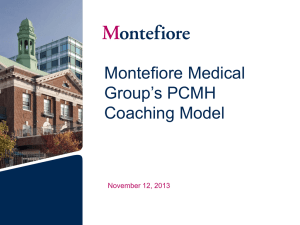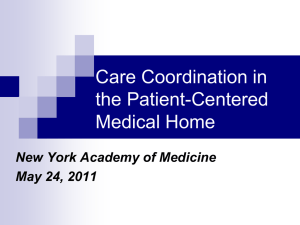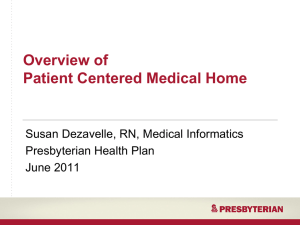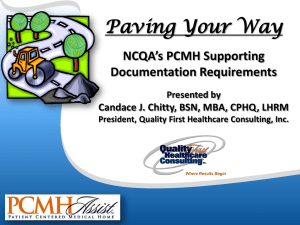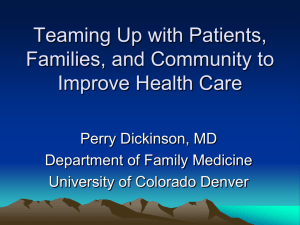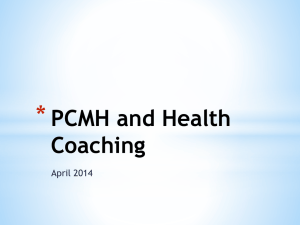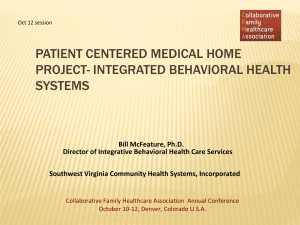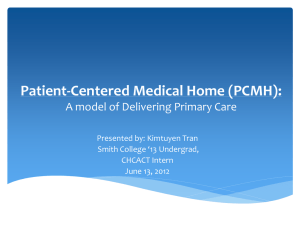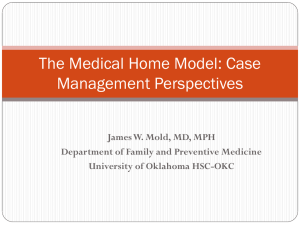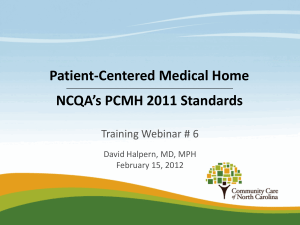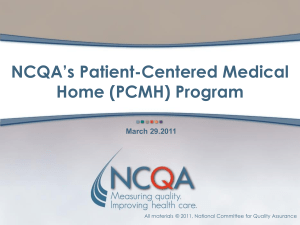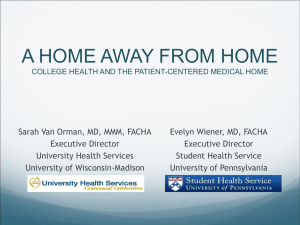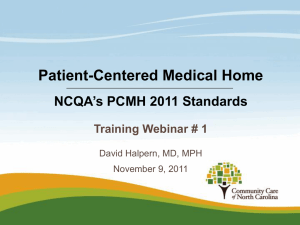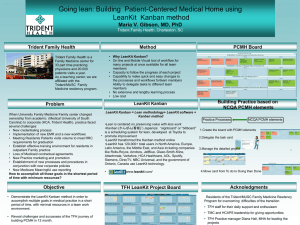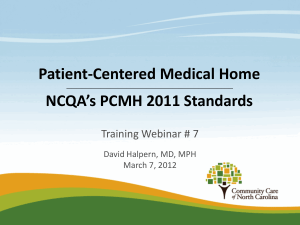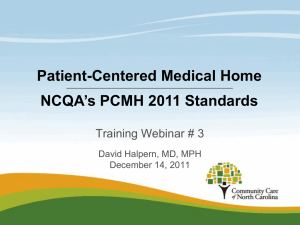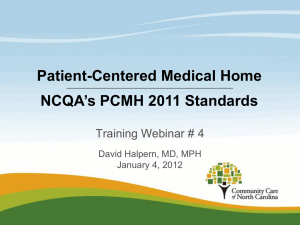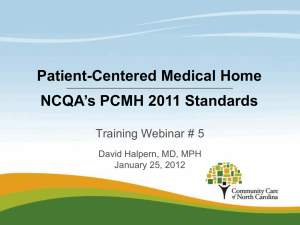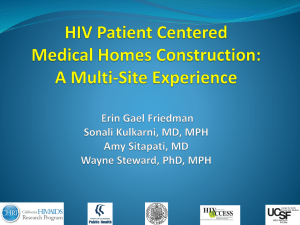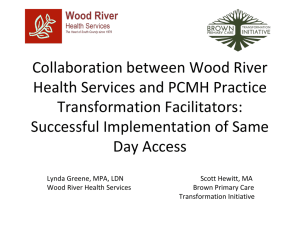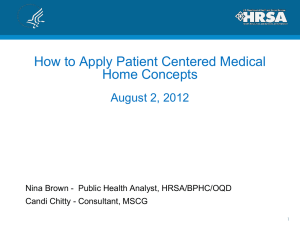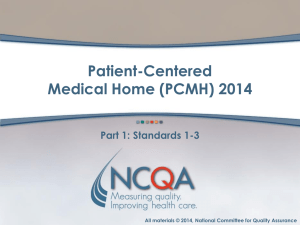Organizational Assessment Toolkit
advertisement
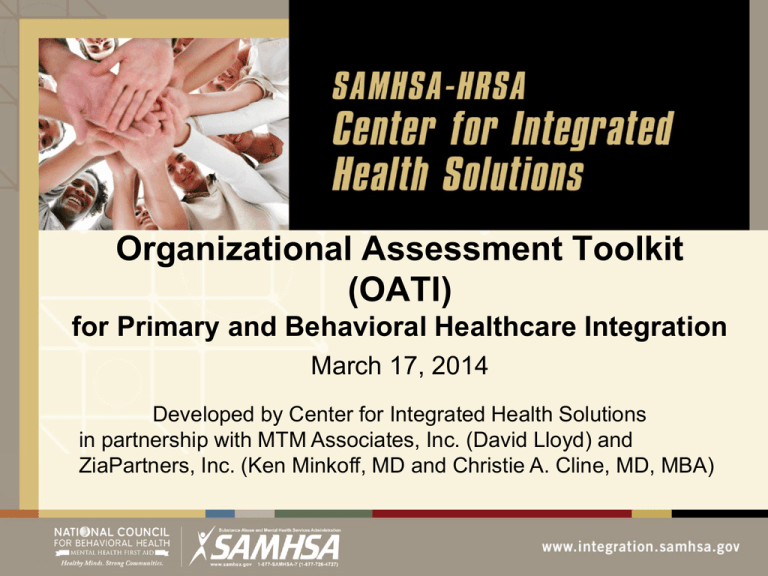
Organizational Assessment Toolkit (OATI) for Primary and Behavioral Healthcare Integration March 17, 2014 Developed by Center for Integrated Health Solutions in partnership with MTM Associates, Inc. (David Lloyd) and ZiaPartners, Inc. (Ken Minkoff, MD and Christie A. Cline, MD, MBA) Slides for today’s webinar are available on the CIHS website at: www.Integration.samhsa.gov under About Us/Webinars Today’s Presenter Kenneth Minkoff, MD Senior Systems Consultant ZiaPartners, Inc. kminkov@aol.com What is the purpose of OATI? To help any type of health or behavioral health program, organization, partnership, or system to develop integrated care capability to improve care, lower costs, and save lives. Who is OATI designed for? OATI is designed to support an entire organization making progress, and any program in the organization, NOT just a specialty primary health/behavioral health program. This includes: • Primary care providers of any type • Behavioral health providers of any type (including MH, SA, ID/DD, BI) • Organizations working independently or with partners • Organizations working toward PCMH certification, as well as those who are not • Organizations with any resource base or funding model • Organizations just beginning, and those further along Key concepts that inform OATI • Organization-wide assessment and improvement • Bidirectional integration of PH and BH services (PHBHI) • Customer-oriented continuous quality improvement (CQI) Concept 1: Organization-wide assessment and improvement Premise: Individuals with co-occurring PH and BH needs (including trauma) are an expectation in all programs. • These individuals have poorer outcomes and higher costs. • Therefore, all programs need to improve their capability to deliver integrated services. • OATI is designed to help any organization and any program make progress. Concept 2: Bidirectional PHBHI Integration • Individuals and families with PH and BH needs work with a team that addresses both types of needs at the same time. • This “product” of integrated care can be delivered in many ways, in many settings. Key processes in producing bidirectional PHBH integration • Organizational culture focused on high quality customer service for people with PH/BH issues. • Transforming all policies, practices, programming, and financing to support integration. What is integration? • A process over time for the whole organization • Fully articulated customer-oriented CQI process, not a “project” • More than just a referral partner, co-location, or merger • More than hiring special staff • More than achieving special certification (e.g., PCMH) • More than a particular tool, diagnosis, process (e.g., SBIRT) or program (e.g., IMPACT) • Involves multiple series of rapid cycle changes over time Concept 3: Customer-oriented CQI • Customer experience first • Progress not perfection – achievable improvements over time • Continuous cycles of change (Plan-Do-Study-Act) The four core OATI tools are used to frame a CQI process. OATI also includes a CQI Reference Guide that provides basic “how-to” info on improving integration. Integration and PCMH certification OATI provides a crosswalk with the six major NCQA Standards Focus Areas (PCMH 1-6). OATI illustrates how each area connects to improving PHBH integration. 1. Enhance access and continuity 2. Identify and manage populations 3. Plan and manage care 4. Provide self-care support 5. Track and coordinate care 6. Measure and improve performance (QI) The five major sections of the OATI 1. Introduction 2. The four major assessment tools 3. Customer-oriented CQI reference guide 4. Addendum: Optional tools and change management materials 5. Appendix: References and PHBHI resources Section 2: The four major assessment tools • Designed to be used in order, but each can stand alone. • Best positioned within a vision-driven, organized change process. Section 2: The four major assessment tools 1. Partnership Checklist: Assessing need for partner, and next steps in more effective partnerships Section 2: The four major assessment tools 2. Executive Walkthrough: Assessing and improving the “customer experience” of individuals with PH/BH needs Section 2: The four major assessment tools 3. Administrative Readiness Tool (ART): Assessing and improving key administrative practices and processes (open access, data collection, billing and revenue collection, etc.) necessary for integration Section 2: The four major assessment tools 4. COMPASS-PH/BH: Assessing and improving clinical policies, procedures and practices that support successful delivery of integrated care in any program. Section 3: CQI Reference Guide • Includes introduction to change management, change teams, rapid cycle change, and PDSA cycles. • Illustrates concrete, practical application of CQI (PCMH 6) to common improvement areas for programs and organizations. • Includes optional organizational QI capacity assessment tool (QI-IQ). Common starting places for change (matched to PCMH focus area) Creating a Relationship (PCMH 1) • Customer service (welcoming, hope, and engagement) • Facilitating integrated access • Improving “rate of return” (continuity) Seeing the Issues (PCMH 2) • Screening and identification • Integrated assessment documentation Common starting places for change (matched to PCMH focus area) Providing Helpful Care (PCMH 3) • Integrated care planning & stage-matched interventions • Implementation of collaborative care & disease management protocols Providing Cost-effective Care (PCMH 4) • Maximizing revenue flow for integrated care delivery • Improving outcomes for high utilizers Common starting places for change (matched to PCMH focus area) Providing Helpful Care (PCMH 3) • Integrated care planning & stage-matched interventions • Implementation of collaborative care & disease management protocols Providing Cost-effective Care • Maximizing revenue flow for integrated care delivery • Improving outcomes for high utilizers Common starting places for change (matched to PCMH focus area) Supporting Self-care (PCMH 4) • Implementing self-management skills training • Providing access to peer health coaching and recovery support Working as a Team (PCMH 5) • Information sharing • Cross-consultation, collaboration and teamwork Common starting places for change (matched to PCMH focus area) Building a Capable Workforce (PCMH-All) • Workforce development Section 4: Optional tools and materials Includes the following: • Strategic planning tool (SPIN) • Project management tools and matrices • Program improvement planning tools Use these if you find them helpful. Section 5: References and resources • Includes an array of practical material that has been gathered by the Center for Integrated Health Solutions. • Examples include references, screening tools, clinical tools, program references, integrated care materials, helpful links. Have fun improving integration in YOUR program or organization!!! For More Information… Additional Resources For More Information… Contact Information Questions? SAMHSA-HRSA Center for Integrated Health Solutions integration@thenationalcouncil.org Thank you for joining us today. Please take a moment to provide your feedback by completing the survey at the end of today’s webinar.
